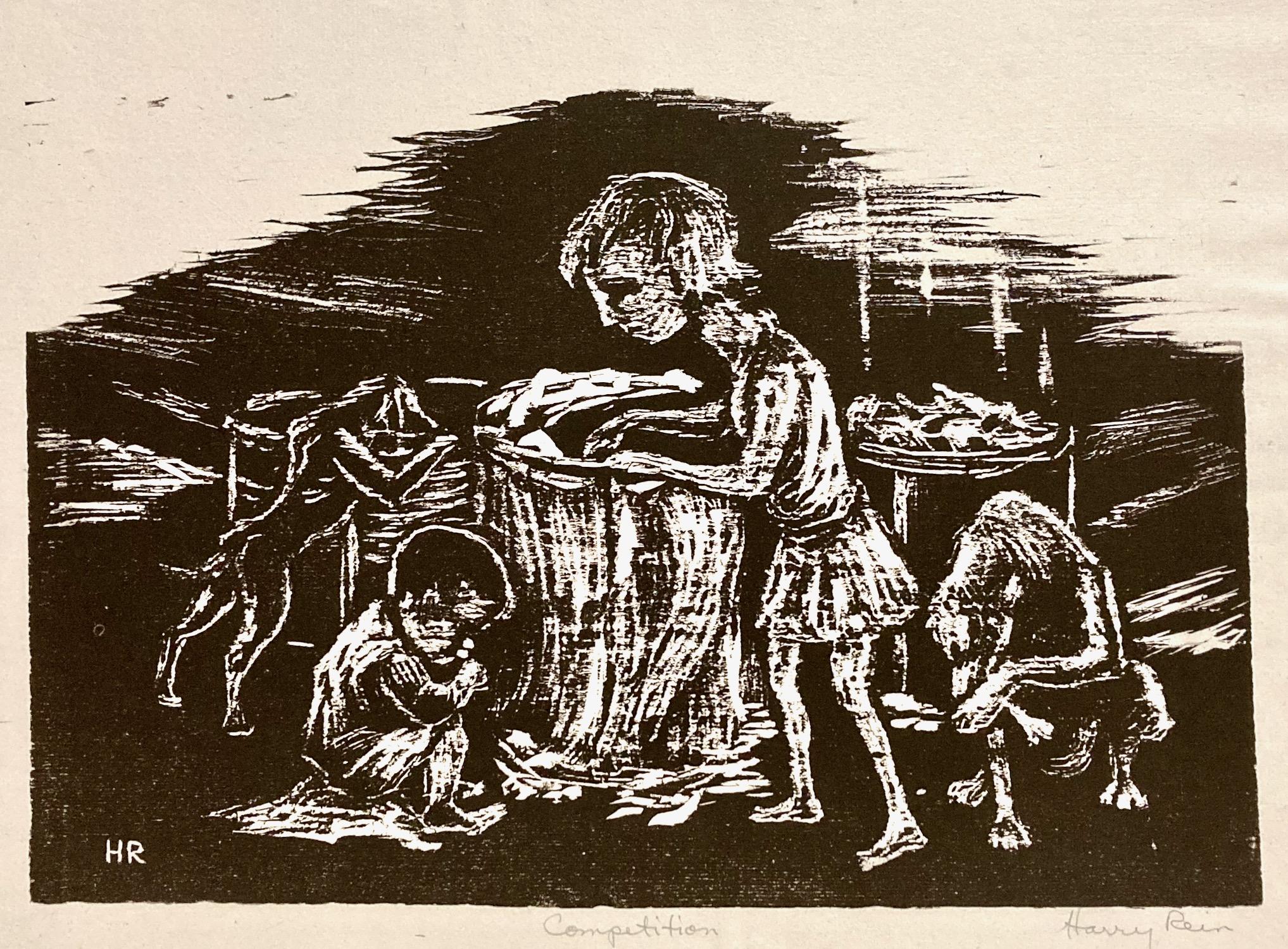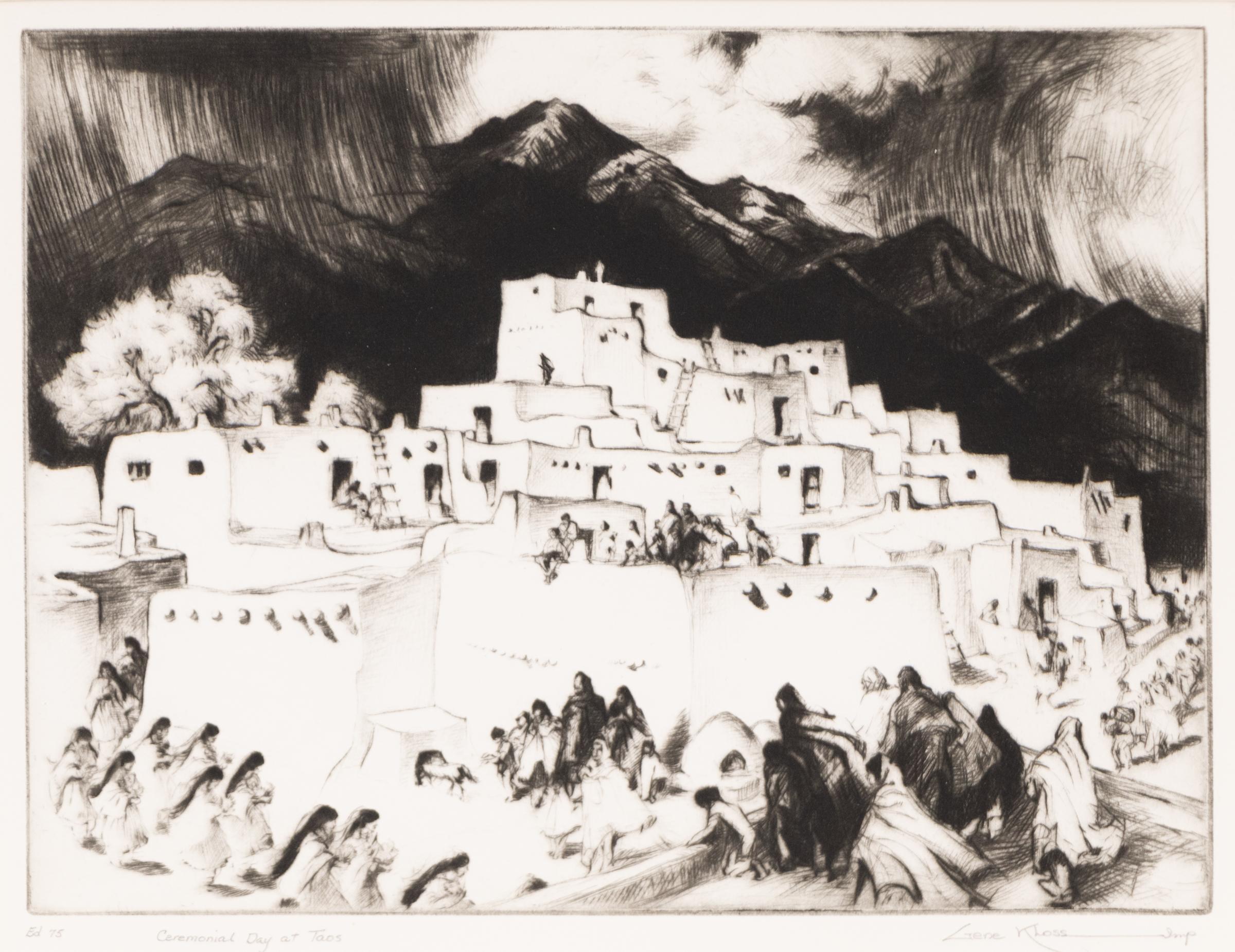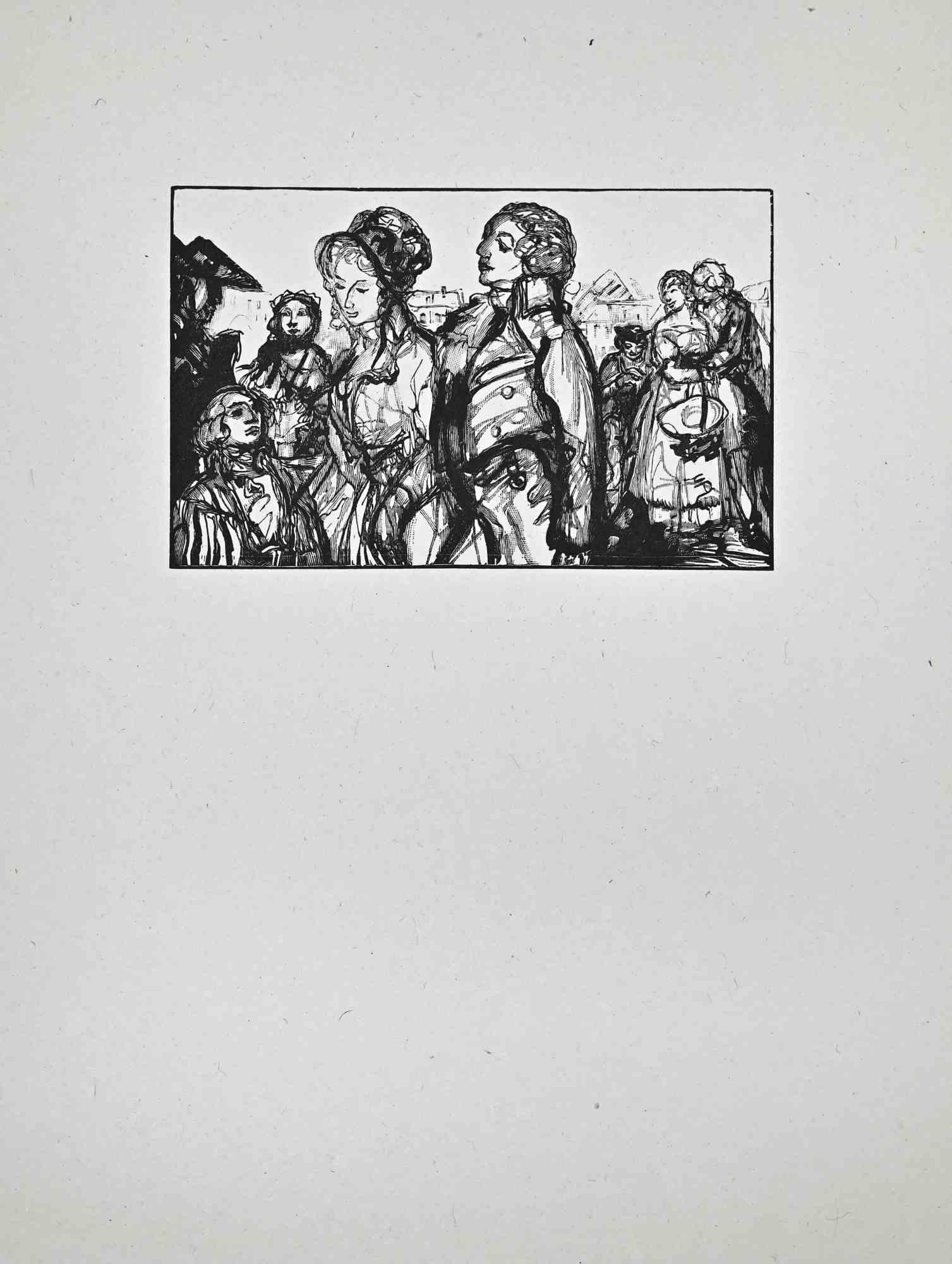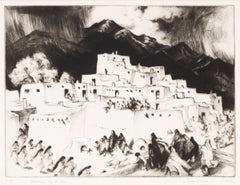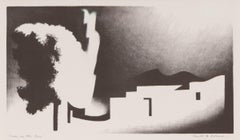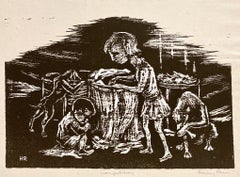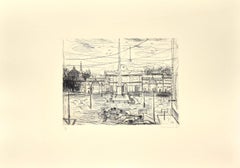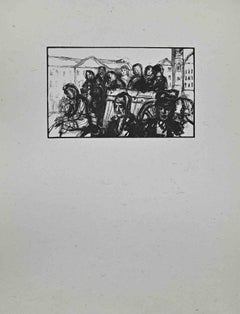Items Similar to Saturday Morning Market, Taos Plaza, New Mexico, 1950s Figural Linocut Print
Video Loading
Want more images or videos?
Request additional images or videos from the seller
1 of 13
Barbara LathamSaturday Morning Market, Taos Plaza, New Mexico, 1950s Figural Linocut Print
$1,650
£1,248.34
€1,440.78
CA$2,304.59
A$2,562.26
CHF 1,341.19
MX$31,425.33
NOK 17,076.75
SEK 16,122.48
DKK 10,751.54
Shipping
Retrieving quote...The 1stDibs Promise:
Authenticity Guarantee,
Money-Back Guarantee,
24-Hour Cancellation
About the Item
"Saturday Morning (Market, Taos Plaza, New Mexico)" is a striking 1950s modernist linocut print by renowned New Mexican artist Barbara Latham. This vivid print captures a bustling Saturday morning at the Taos Pueblo market, featuring a horse and cart, Native American figures, traditional adobe buildings, and the majestic mountains in the background. Latham's masterful use of line and composition highlights the vibrant daily life in Taos, offering a glimpse into a time now passed. The print is presented in a custom frame with all archival materials, with outer dimensions measuring 16 x 17 ¾ inches and an image size of 8 ½ x 10 ½ inches.
About the Artist:
Barbara Latham (1903–1989) was a talented artist whose career began as a commercial artist before evolving into a prolific figure in the Taos art scene. She first visited Taos in 1925 to gather inspiration for a greeting card, but the artistic community, including her future husband Howard Cook, drew her in. Latham's artwork is known for its depiction of everyday life, particularly genre scenes set in Taos Pueblo, reflecting her belief in the availability of art for all. Her work for children's books and her linocut prints capture the spirit of the American Southwest with fluid brushstrokes and captivating color palettes.
Born in Walpole, Massachusetts, Latham studied at Norwich Art School and Pratt Institute before studying with Andrew Dasburg at the Art Students League in Woodstock. After meeting Howard Cook, the couple traveled to Paris and later to Taxco, Mexico, where they were inspired by the works of Mexican muralists like Diego Rivera. Latham's work during the Depression was populist, contributing prints to organizations like the American Artists Group.
Settling in Taos, Latham embraced the dynamic energy of the region, portraying everyday scenes with an authenticity that celebrated the diverse and vibrant community. Her post-World War II work evolved, with her later pieces focusing on minimal backgrounds and elegant forms that captured figures in motion. Latham's style balanced abstraction and modernist sensibilities, infusing energy and rhythm into her genre scenes. Her legacy continues to influence and inspire the art community, particularly in her commitment to capturing the essence of everyday life with modernist flair.
This print, "Saturday Morning (Market, Taos Plaza, New Mexico)," is a testament to Latham's skill in portraying the life and culture of Taos with striking simplicity.
- Creator:Barbara Latham (1896 - 1989, American)
- Dimensions:Height: 16 in (40.64 cm)Width: 17.75 in (45.09 cm)
- Medium:
- Movement & Style:
- Period:
- Framing:Frame IncludedFraming Options Available
- Condition:very good to excellent vintage condition. Custom frame has recently been added.
- Gallery Location:Denver, CO
- Reference Number:Seller: 191991stDibs: LU2731846713
About the Seller
5.0
Gold Seller
Premium sellers maintaining a 4.3+ rating and 24-hour response times
Established in 1979
1stDibs seller since 2013
290 sales on 1stDibs
Typical response time: 13 hours
- ShippingRetrieving quote...Shipping from: Denver, CO
- Return Policy
Authenticity Guarantee
In the unlikely event there’s an issue with an item’s authenticity, contact us within 1 year for a full refund. DetailsMoney-Back Guarantee
If your item is not as described, is damaged in transit, or does not arrive, contact us within 7 days for a full refund. Details24-Hour Cancellation
You have a 24-hour grace period in which to reconsider your purchase, with no questions asked.Vetted Professional Sellers
Our world-class sellers must adhere to strict standards for service and quality, maintaining the integrity of our listings.Price-Match Guarantee
If you find that a seller listed the same item for a lower price elsewhere, we’ll match it.Trusted Global Delivery
Our best-in-class carrier network provides specialized shipping options worldwide, including custom delivery.More From This Seller
View All1953 Signed Black & White Etching Print 'Ceremonial Day at Taos' New Mexico
By Gene Kloss
Located in Denver, CO
"Ceremonial Day at Taos" is a captivating vintage black and white etching by renowned American artist Gene Kloss. Created in 1953, this drypoint etching depicts the vibrant life of T...
Category
1950s American Modern Landscape Prints
Materials
Etching
1930s Lithograph Print of Tourists at Garden of the Gods, Colorado Springs, CO
By Charles Locke
Located in Denver, CO
"Photo Opportunity" is a rare and captivating original lithograph by American Modernist Charles Wheeler Locke (1899–1983), created circa 1935. This lim...
Category
1930s American Modern Figurative Prints
Materials
Lithograph, Paper
House in the Sun, 1950s Modernist Black & White Lithograph of New Mexico Adobe
By Kenneth Miller Adams
Located in Denver, CO
House in the Sun is an original 1950 lithograph by renowned New Mexico modernist Kenneth Miller Adams. This striking black and white composition captures the timeless geometry and su...
Category
1950s American Modern Landscape Prints
Materials
Lithograph
WPA-Era Central City, Colorado, 1930s Modernist Lithograph, Cityscape 3/25
By Arnold Rönnebeck
Located in Denver, CO
This 1933 lithograph, Central City, Colorado 3/25, by Arnold Rönnebeck, captures the architectural essence of a historic mining town during the Great Depression. Rendered in black an...
Category
1930s American Modern Figurative Prints
Materials
Lithograph
$1,350 Sale Price
50% Off
Corralled Horse, 1940s WPA-Era American Modernist Etching, Artist’s Proof
By Ethel Magafan
Located in Denver, CO
"Corralled Horse" is a 1940s WPA-era modernist etching by acclaimed American artist Ethel Magafan (1916–1993), renowned for her dynamic murals and evocative depictions of the America...
Category
1940s American Modern Figurative Prints
Materials
Etching
1950s Signed New Mexico Winter Lithograph – Original Vintage Snowy Landscape Art
By Kenneth Miller Adams
Located in Denver, CO
Step into the serene beauty of a New Mexico winter with this stunning 1950s signed lithograph, New Mexico Village Under Snow, by acclaimed artist Kenneth Miller Adams. This rare vint...
Category
1950s American Modern Landscape Prints
Materials
Lithograph
You May Also Like
Mercado de la Soledad, Cubist Etching by Alfredo Zalce
By Alfredo Zalce
Located in Long Island City, NY
Artist: Alfredo Zalce, Mexican (1908 - 2003)
Title: Mercado de la Soledad
Year: 1990
Medium: Etching, signed and numbered in pencil
Edition: 100
Image Size: 8.25 x 25 inches
Size: 16...
Category
1990s Modern Figurative Prints
Materials
Etching
Harry R. Rein, Competition, 1936-39, WPA linocut
Located in New York, NY
If ever there was an image that fit the description of 'Ashcan,' Harry Rein's Competition, made for the NYC WPA, is clearly it!
Some impressions have the WPA sstamp, including the o...
Category
1930s Ashcan School Landscape Prints
Materials
Linocut
Roma, Piazza Del Popolo - Etching by N. Gattamelata - Late 20th Century
By Nazareno Gattamenata
Located in Roma, IT
Roma-Piazza del Popolo is a black and white etching realized by Nazareno Gattamelata in the second half of XX century.
Hand signed by the artist on the lower right margin: Gattamela...
Category
Late 20th Century Figurative Prints
Materials
Etching
The Carriage of Women - Original Woodcut Print by Paul Baudier - 1930s
Located in Roma, IT
The Carriage of Women is an original woodcut print on ivory-colored paper realized by Paul Baudier (1881-1962) in the 1930s.
Very Good condition.
Paul Baudier, (born October 18, 18...
Category
1930s Modern Figurative Prints
Materials
Woodcut
The Nobel Holiday - Woodcut Print by Paul Baudier - 1930s
Located in Roma, IT
The Nobel Holiday is a woodcut print on ivory-colored paper realized by Paul Baudier (1881-1962) in the 1930s.
Good conditions.
Paul Baudier, (born October 18, 1881 in Paris and di...
Category
1930s Modern Figurative Prints
Materials
Woodcut
The Rest and Wait - Woodcut Print by Paul Baudier - 1930s
Located in Roma, IT
The Rest and Wait is a woodcut print on ivory-colored paper realized by Paul Baudier (1881-1962) in the 1930s.
Good conditions.
Paul Baudier, (born October 18, 1881 in Paris and di...
Category
1930s Modern Figurative Prints
Materials
Woodcut
More Ways To Browse
Paris Market Vintage
Railroad Bell
Russian Porcelain Easter Egg
Salvador Dali Christ
Salvador Dali Purgatory 1
Salvador Dali Shakespeare
Singing Bird Clock
St John Collection By Marie Gray
Suite De 180 Dessins De Picasso
Suzanne Duchamp
The 19th Century Trash Can
Toshikata Mizuno
Used Rubiks Cubes
Vintage Cardinal Bird
1950s Showgirl
Adam Camp
Alessandro Tofanelli
Alfons Mucha
